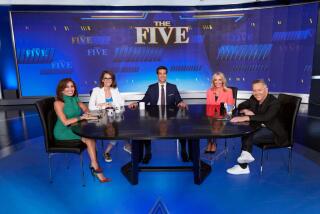Column: Why cutting the pay-TV cord turned out to be a good move
The pay-TV industry lost more than a million subscribers last year, four times the number that skedaddled a year earlier, according to market researcher SNL Kagan.
That doesn’t mean cable, satellite and other pay-TV companies are gasping for breath. But it does mean that cord cutting is having a clear impact on the industry — and that can only be good for consumers who have grown sick of paying for dozens, even hundreds, of channels they never watch.
Readers have asked for updates about my experience since I cut the pay-TV cord in January, slashing my monthly Time Warner Cable bill in half (I still receive broadband Internet and home-phone service from the company).
I can say without reservation that the experience has been a good one. Although I’ve said adios to two channels that used to be part of my regular viewing diet — CNN and AMC — I’ve found:
•Life goes on. I still get plenty of news without CNN and, surprisingly, I didn’t mourn the loss of “The Walking Dead.” By all accounts, the latest season, which ended Sunday, wasn’t very tasty.
•Roku is an excellent way to access streaming video on my TV. I have more than enough viewing options with a stand-alone, $15-a-month subscription to HBO and with Amazon Prime, which I already had for the free two-day shipping.
•With TV now an on-demand experience, I watch what I want when I want. The few times I’ve kicked back and aimlessly surfed the networks and local channels using my HD antenna, I grew so tired of commercials that I turned off the set.
•As a result, I’m reading more.
Krissy Harris knows what I’m talking about. Like me, the 46-year-old Encino resident cut her $150-a-month Time Warner Cable bill to $60 in November by going Internet-only. She gets movies and TV shows via Hulu for $8 monthly.
“I’m reading more too,” Harris told me. “But what I’ve really noticed is that I’m no longer watching stupid shows like ‘Real Housewives.’ I’m watching better shows because there are so many good things available, especially for binge watching.”
Convergence Consulting Group predicted this week that at least another million people will cut the pay-TV cord this year. By December, it said, about 27 million U.S. households will have abandoned pay-TV services.
“Consumers have more options than ever,” said Bruce Leichtman, president of the media consulting firm Leichtman Research Group. “Because of Internet-delivered video, you have the ability to cobble together your own video service.”
But cobble carefully. Costs can quickly soar if you go all-in with every available streaming service. Netflix, Hulu, Amazon Prime and premium channels like HBO, Showtime and Starz offer free trials before you have to commit to monthly payments. Check them out and see what’s best for you.
The wide array of choices for cord cutters is having an impact across the pay-TV spectrum. Take the example of Time Warner Cable’s Dodgers channel.
The cable giant paid $8.35 billion for exclusive rights to distribute Dodgers games. To make that whopping sum pencil out, the company needed to stick all subscribers of all other pay-TV providers with a $5 extra charge per month.
However, DirecTV and other pay-TV outfits balked at such a huge rate hike. They knew it would be dangerous to give subscribers yet another reason to jump ship. Even when Time Warner cut the per-subscriber price to less than $4, the answer was still no.
Give cord cutters some of the credit for that. In the past, pay-TV companies had customers by the short hairs and could dictate terms. Those days are gone.
Twitter announced this week that it will stream 10 Thursday night National Football League games for free. Yahoo will stream a free Major League Baseball game every day.
This is music to the ears of West Hills resident George Lewis. His Dish Network satellite bill grew to $110 a month. So last summer he and his wife cut the cord and they now pay $55 monthly for Time Warner Internet service.
“I miss all the sports we used to have,” Lewis, 44, told me. “But when I look back at how much we were paying, I can take the loss.”
He and his wife shell out $20 monthly for the streaming service Sling TV, which includes ESPN in its 20-channel lineup. Lewis also turns to various websites for his sports fix.
“It’s not the same as having lots of sports channels,” he said. “But you don’t need the whole package Dish or Time Warner wants to sell you. You can adapt.”
SIGN UP for the free Opinion newsletter >>
The growing presence of live sports online tells me that pay-TV companies know they won’t be able to keep making non-sports fans subsidize the costly viewing pleasure of sports enthusiasts.
ESPN currently represents almost $7 of the typical pay-TV bill, whether or not you watch the channel. MoffettNathanson analyst Michael Nathanson estimates that if ESPN were sold on an a la carte basis, it would run about $36 a month based on current demand and licensing agreements.
Live online streaming of football and baseball shows how archaic the old pay-TV model has become. Pretty soon, sports fans like Lewis will pay only for the games they want to see, just like iTunes users pay only for the songs they like. The market will determine reasonable pricing.
We’ll also see more so-called skinny bundles of channels such as Sling TV. Cheaper, competitive programming packages are the only way that pay-TV companies will stay in the game.
Comcast already has introduced a $15 skinny bundle. Charter Communications, which is buying Time Warner Cable, is experimenting with its own mini-package starting at $13.
This is all because of cord cutting. Now that pay-TV companies are feeling the heat of actual competition, they’re forced to step up their game — or go extinct.
That’s evolution for you.
David Lazarus’ column runs Tuesdays and Fridays. He also can be seen daily on KTLA-TV Channel 5 and followed on Twitter @Davidlaz. Send your tips or feedback to david.lazarus@latimes.com.
MORE FROM DAVID LAZARUS
Orange County program makes donating leftover food easier
Prudential pulls a fast one on long-term care insurance policyholders
Starbucks’ commitment to donate leftover food to charity deserves praise







